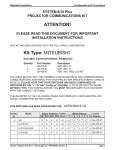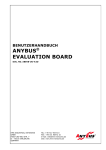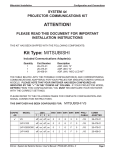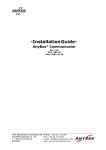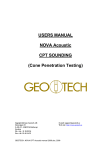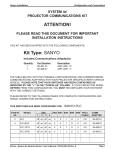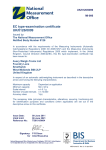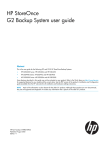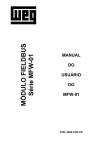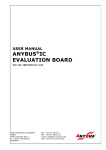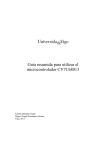Download Aktakom ABM-4083 User manual
Transcript
USER MANUAL ANYBUS® EVALUATION BOARD DOC. NO. ABSEVB-UM-4.0E HMS INDUSTRIAL NETWORKS GMBH HAID-UND-NEU STR. 7 D – 76316 KARLSRUHE GERMANY TEL: +49 721 96472 0 FAX: +49 721 96472 10 e-mail: [email protected] web: www.hms-networks.de ® ANYBUS-S EVALUATION BOARD User Manual Version 4.0e 2004-05-11 Revision Notes Index Date Chapter Autor Revision Revision note 1 2 3 4 2001-05-05 2001-11-13 2002-01-25 2004-05-10 All 4.4 All All Mat Mat Mat Mat 1.0 2.0e 3.0e 4.0e Build Sample code corrected Extended Functionality added Rebuild for FW-version 4.0 Preface This document describes the technical features and usage of the AnyBus-S/M Evaluation Board. The Evaluation Board allows you to set up a complete development environment for creating applications which use the AnyBus-S/M Modules and/or other AnyBus products. The Evaluation Board is supplied with the Keil µVision2 Development Tool, which allows you to test and debug program code that you have written. The Evaluation Board is suitable for AnyBus-S/M parallel modules, AnyBus-S serial modules, AnyBus IC and AnyBus Communicator/ComAdapter. Support for further AnyBus products is being developed. ! Please refer to the appendix for a list of supported AnyBus-S/M modules. The information and illustrations in this document are not binding. HMS reserves the right to make modifications and changes if necessary. HMS is not responsible for errors which are caused by incorrect information in this document. AnyBus® is a registered trademark of HMS Industrial Networks AB. Proprietary names and trademarks in this document are protected by law and belong to the respective owners. HMS INDUSTRIAL NETWORKS GMBH 2 ANYBUS-S EVALUATION BOARD User Manual Version 4.0e 2004-05-11 Table of contents Revision Notes ...................................................................................................................................................................2 Preface................................................................................................................................................................................2 1. Introduction...............................................................................................................................................................4 1.1 Scope of delivery ................................................................................................................................................4 1.2 System requirements ...........................................................................................................................................4 1.3 Related documents ..............................................................................................................................................4 2. Hardware description ...............................................................................................................................................5 2.1 AnyBus-S Evaluation Board external .................................................................................................................5 2.2 AnyBus-S Evaluation Board Circuit Diagram ....................................................................................................6 2.3 Connectors ..........................................................................................................................................................7 2.3.1 Power supply...............................................................................................................................................7 2.3.2 PC Interface/PC1.........................................................................................................................................7 2.3.3 Interface for serial devices PC2...................................................................................................................7 2.3.4 AnyBus-S Application Interface Connector................................................................................................8 2.3.5 Expansion Interface Connector for your own applications. ........................................................................9 2.3.6 LEDs .........................................................................................................................................................10 2.3.7 Push-buttons..............................................................................................................................................11 2.3.8 Potentiometers...........................................................................................................................................11 2.3.9 Jumpers .....................................................................................................................................................12 2.3.10 Power connector for external diagnostic devices ......................................................................................13 2.3.11 Additional PE connection..........................................................................................................................14 2.3.12 Fuse ...........................................................................................................................................................14 2.3.13 Display ......................................................................................................................................................14 2.4 Memory map .....................................................................................................................................................15 2.5 Addressing external devices..............................................................................................................................16 3. Developing with the Evaluation Board..................................................................................................................16 3.1 Opening the case ...............................................................................................................................................16 3.2 Connecting a hardware emulator.......................................................................................................................16 3.3 Connecting your own hardware applications ....................................................................................................16 4. Commissioning ........................................................................................................................................................17 4.1 Easy StartUp initialisation (slave).....................................................................................................................17 4.2 Easy StartUp Initialisierung (Master)................................................................................................................18 4.3 Automatic recognition.......................................................................................................................................19 4.4 Keil monitor mode ............................................................................................................................................20 4.5 Store own programs into Flash..........................................................................................................................23 5. Masters for fieldbus systems ..................................................................................................................................24 6. Appendices...............................................................................................................................................................25 6.1 Diagram of Sample code ...................................................................................................................................25 6.2 Sample Code .....................................................................................................................................................26 6.3 Technical Data ..................................................................................................................................................26 6.4 Abbreviations ....................................................................................................................................................27 6.5 Supported AnyBus-S module types ..................................................................................................................28 6.6 Recommended connector & accessory manufactures .......................................................................................29 6.6.1 AnyBus-S connector .................................................................................................................................29 6.6.2 Power supply connector ............................................................................................................................29 6.6.3 Expansion connector for own applications................................................................................................30 6.6.4 Fuse ...........................................................................................................................................................30 6.6.5 Power Supply ............................................................................................................................................31 6.6.6 Keil µVision2 Development Tool .............................................................................................................31 HMS INDUSTRIAL NETWORKS GMBH 3 ANYBUS-S EVALUATION BOARD User Manual Version 4.0e 2004-05-11 1. Introduction Please contact our technical support department if you have any technical questions. Please refer to the end of the appendix of this document for the address. The appendix also contains a feedback form which you should use if you have any suggestions for improving this product. 1.1 Scope of delivery Designation Description AnyBus-S Evaluation Board Development board for inserting an AnyBus-S/M module, AnyBus-IC or connecting to serial devices. The board contains firmware (EPROM) to allow the AnyBus-S/M Evaluation Board PC based Keil µVision2 Development Tool to communicate with the AnyBus-S/M module. Serial 1:1 cable D-SUB9 socket <–> D-SUB9 plug AnyBus-S Evaluation Board CD-ROM Contains: Example software, tools and other support equipment for development of embedded AnyBus-S/M environments Keil Development Tools CD-ROM Contains: µVision2 Development Tool, evaluation version (limited to 2k program code) Data sheets for the µC (80XXX) 1.2 System requirements Part Requirement IBM Compatible PC min. Pentium I with 100 MHz, 32MB RAM, free RS232 Port with D-SUB9 m Operating System Windows 9X,ME,NT,2000,XP Power Supply 5V DC, 800mA AnyBus Fieldbus Module AnyBus-S/M parallel; AnyBus-S serial; AnyBus ComAdapter; AnyBus-IC (only over additional hardware); AnyBus-Communicator 1.3 Related documents Name Description Document Number AnyBus-S Design Guide Serial Interface General Engineering information for In-Design of AnyBus-S using Serial Interface (SCI) ABS-DESIGN-SER AnyBus-S Appendix - Profibus Data sheet for AnyBus-S Profibus-DP ABS-APPENDIX-PDP AnyBus-S Appendix - InterBus Data sheet for AnyBus-S InterBus ABS-APPENDIX-IBS AnyBus-S Appendix - DeviceNet Data sheet for AnyBus-S DeviceNet ABS-APPENDIX-DEV AnyBus-S Appendix - CANopen Data sheet for AnyBus-S CANopen ABS-APPENDIX-COP AnyBus-S Appendix - ControlNet Data sheet for AnyBus-S ControlNet ABS-APPENDIX-CNT AnyBus-S Appendix - Ethernet Data sheet for AnyBus-S Ethernet ABS-APPENDIX-ETN AnyBus-S Appendix - Modbus Plus Data sheet for AnyBus-S Modbus Plus ABS-APPENDIX-MBP AnyBus-S Shortform Datasheet General Information of AnyBus-S ABS-SHORTFORM HMS INDUSTRIAL NETWORKS GMBH 4 ANYBUS-S EVALUATION BOARD User Manual Version 4.0e 2004-05-11 2. Hardware description 2.1 AnyBus-S Evaluation Board external 1 3 2 11 4 5 10 6 7 9 8 Figure 1: AnyBus-S Evaluation Board 1. Potentiometer for Analogue values 2. Mounting pins for fixing a AnyBus-S/M module 3. Application connector for AnyBus-S Modules 4. Power supply connector (5V DC, 800 mA) 5. Serial connector for serial devices 6. Serial connector to PC 7. Fuse (250V, 800mA, T) 8. 2*16 Character Display 9. Diagnosis & port LEDs 10. User switches 11. Expansion connector for own applications (optional) HMS INDUSTRIAL NETWORKS GMBH 5 ANYBUS-S EVALUATION BOARD User Manual Version 4.0e 2004-05-11 2.2 AnyBus-S Evaluation Board Circuit Diagram Figure 2: Evaluation Board Circuit HMS INDUSTRIAL NETWORKS GMBH 6 ANYBUS-S EVALUATION BOARD User Manual Version 4.0e 2004-05-11 2.3 Connectors 2.3.1 Power supply The Evaluation Board must be connected to an external 5V/800mA power supply using a pluggable screw connector. A protection diode is provided to protect against polarity reversal. In addition, the Evaluation Board is protected against short circuits with an on-board fuse. Please note that over voltage protection is not available. Over voltage will damage the device! | + GND +5V Evaluation Board Top View Figure 3: Position of power supply connector 2.3.2 PC Interface/PC1 A PC is required to test various initialization methods using the Keil C51 Evaluation Compiler/Debug software to test your applications and download them to the Evaluation Board. Further information on the Evaluation Board Development Toolkit and the Keil C51 Development Tool is contained in chapter 4.4. The serial interface of the Evaluation Board is connected directly to a serial interface of an IBM compatible PC (COM1 – COM8) using the supplied cable. The RS232 interface already has crossed over Tx and Rx lines and thus the connection is made with a 1:1 cable. The following pins are used: 1. RxD (Pin 2) 2. TxD (Pin 3) 3. GND (Pin 5) Figure 4: Front view of D-SUB 9 PC connector 2.3.3 Interface for serial devices PC2 The Evaluation Board is connected to serial devices using a D-SUB9 connector. The RS232 interface already has crossed over Tx and Rx lines and thus the connection is made with a 1:1 cable. The following pins are used: 1. RxD (Pin 2) 2. TxD (Pin3) 3. GND (Pin 5) 4. 5V (Pin 1, see chap.2.3.10) Figure 5: Front view of the D-SUB 9 PC2 connector HMS INDUSTRIAL NETWORKS GMBH 7 ANYBUS-S EVALUATION BOARD User Manual Version 4.0e 2004-05-11 2.3.4 AnyBus-S Application Interface Connector The AnyBus-S/M Application Interface Connector on the Evaluation Board is used to plug in the AnyBus-S/M module. The pin assignments are shown in following table: 2 1 34 33 Figure 6: Position of the AnyBus-S/M application interface Pin Name Description Note 1 +5V +5V AnyBus Module power supply 2 GND GND " 3 - NC Not connected 4 - NC Not connected 5 +5V +5V AnyBus Module power supply 6 GND GND " 7 TX Transmit Serial interface (for firmware download). Internally pulled-up with 100 kΩ on the AnyBus-S module. 8 RX Receive Serial interface (for firmware download). Internally pulled-up with 100 kΩ on the AnyBus-S module. 9 - 18 A0 - A9 Address line 0 - 9 Directly connected to the DPRAM. Pin 9 = LSB 19 - 26 D0 - D7 Data bit 0 - 7 Directly connected to the DPRAM. Pin 19 = LSB 27 /BUSY Busy signal Open collector output. Internally pulled-up with 10 kΩ on the AnyBusS module. 28 /IRQ Interrupt signal Open collector output. Internally pulled-up with 10 kΩ on the AnyBusS module. 29 /RD Read signal Active low input. 30 /WR Write signal Active low input. 31 /CE Chip enable signal Active low input. 32 /RESET Reset signal Active low input. Internally pulled-up with 35-75 kΩ on the AnyBus-S module. 33 A10 Address line 10 Directly connected to the DPRAM. Internally pulled-up with 10 kΩ on the AnyBus-S module. 34 A11 Address line 11 Directly connected to the DPRAM. Internally pulled-up with 10 kΩ on the AnyBus-S module. Enables 4K DPRAM access HMS INDUSTRIAL NETWORKS GMBH 8 ANYBUS-S EVALUATION BOARD User Manual Version 4.0e 2004-05-11 2.3.5 Expansion Interface Connector for your own applications. An extension interface is provided for connecting to your own hardware applications. It allows you to access all of the unused ports of the µC. The solder pads are designed for a standard DIN41612 edge connector, but you can also attach individual wires if required. In order to avoid damage to the Evaluation Board, it is important to observe the standard guidelines for soldering electronic components. The pin assignments are shown in following table: Number Row A (bottom row) Row B (upper row) 1 VCC VCC 2 nc nc 3 nc nc 4 nc nc 5 P1.1 / INT4 / CC1 P1.0 / INT3 / CC0 6 P1.3 / INT6 / CC3 / (ABS: Pin 13 A04) P1.2 / INT5 / CC2 7 P1.5 / T2EX P1.4 / INT2 / CC4 8 P1.7 / T2 P1.6 / CLKOUT 9 P3.6 / WR / (ABS: Pin 30 /WR) P3.7 / RD / (ABS: Pin 29 /RD) 10 P3.4 / T0 / (ABS: Pin 27 /BUSY) P3.5 / T1 11 P3.2 / INT0 P3.3 / INT1 / (ABS: Pin 28 /IRQ) 12 P3.0 / RXD0 / (ABS: Pin 7 TX) P3.1 / TXD0 / (ABS: Pin 8 RX) 13 P4.6 / CM6 P4.7 / CM7 14 P4.4 / CM4 P4.5 / CM5 15 P4.2 / CM2 P4.3 / CM3 16 P4.0 / CM0 P4.1 / CM1 17 VREF_NEG VREF_POS 18 P7.1 / AN1 P7.0 / AN0 19 P7.3 / AN3 P7.2 / AN2 20 P7.5 / AN5 P7.4 / AN4 21 P7.7 / AN7 P7.6 / AN6 22 P8.2 / AN10 P8.3 / AN11 23 P8.0 / AN8 P8.1 / AN9 24 P6.6 / Bi-directional I/O P6.7 / Bi-directional I/O 25 P6.4 / Bi-directional I/O P6.5 / Bi-directional I/O 26 P6.2 / Bi-directional I/O / TXD1 P6.3 / Bi-directional I/O 27 P6.0 / Bi-directional I/O / ADST P6.1 / Bi-directional I/O / RXD1 28 P5.1 / CCM1 P5.0 / CCM0 29 P5.3 / CCM3 P5.2 / CCM2 30 P5.5 / CCM5 P5.4 / CCM4 31 P5.7 / CCM7 P5.6 / CCM6 32 GND GND HMS INDUSTRIAL NETWORKS GMBH 9 ANYBUS-S EVALUATION BOARD User Manual Version 4.0e 2004-05-11 2.3.6 LEDs The Evaluation Board is provided with the following status and diagnostic LEDs: Designation Color Description Pwr Green Power feed to the Evaluation Board S2:PC TxD Red Tx line for the PC interface (µC serial port SER1) S2:PC RxD Red Rx line for the PC interface (µC serial port SER1) S1:PC TxD Red Tx line for the serial AnyBus interface, (µC serial port SER0), used by AnyBus-S serial module or serial devices S1:PC RxD Red Rx line for the serial AnyBus interface, (µC serial port SER0), used by AnyBus-S serial module or serial devices µC-P4 0 Green Directly connected to port I/O line 4.0 over pull down resistors. (High active) µC-P4 1 Green Directly connected to port I/O line 4.1 over pull down resistors. (High active) The power LED indicates that the 5V DC power feed is present. The LED S2:TxD flashes when data is being sent to the PC. The LED S2:RxD flashes when data is received from the PC. The LED S1:TxD flashes when data is being sent to the ComAdapter. The LED S1:RxD flashes when data is being received from the ComAdapter. These LEDs are only for diagnostic purposes and cannot be controlled by your program. LED µC-P4 0/1 can be controlled by software. Power feed LED Port LEDs for state output of port 4.0 and 4.1 Diagnostics telegrams. LED’s for serial communication via SER1 (PC) Figure 7: Position of LED’s Diagnostics telegrams. LED’s for serial communication via SER0 (AB-IC, ser.devices) HMS INDUSTRIAL NETWORKS GMBH 10 ANYBUS-S EVALUATION BOARD User Manual Version 4.0e 2004-05-11 2.3.7 Push-buttons The Evaluation Board is provided with four push-buttons as follows: Designation Color Number µC/ABS/M signal Description PROG Blue T1 P1.0 (Pin 36) of the µC Key function “Programming” APP Blue T2 P1.1 (Pin 35) of the µC Key function “Application” RESET Red T3 Reset circuit for the µC. Controls /RESET on Pin 10 of the µC. Triggers a hardware reset on the AnyBus-S Evaluation Board AB-RESET Red T4 /RESET (Pin 32) on the AB-S/M /RO (Pin 82) on the µC Triggers a hardware reset on the AnyBus-S/M module only Figure 8: Position of buttons The functions of each of the buttons and/or button combinations are described from chapter 4 onwards. 2.3.8 Potentiometers The two potentiometers on the Evaluation Board are used to provide an analog signal for generating user data for data transmission. They are connected as potential dividers and the moving contact is connected to the µC. They can be connected across a fixed 5V supply or an external reference voltage source, depending on jumper settings (see chapter 2.3.10). When the potentiometer is turned, the output voltage varies between 0 V and the supply voltage. The µC contains an analog/digital converter which converts the analog input signal to an integer value between 0 and 255. The µC has a total of eight analog inputs which are connected as follows: µC Port-Pin Expansion Port Pin Potentiometer P7.7 A21 Analog 1 P7.6 C21 Analog 2 P7.5 A20 ----------- P7.4 C20 ----------- P7.3 A19 ----------- P7.2 C19 ----------- P7.1 A18 ----------- P7.0 C18 ----------- HMS INDUSTRIAL NETWORKS GMBH 11 ANYBUS-S EVALUATION BOARD User Manual Version 4.0e 2004-05-11 2.3.9 Jumpers The Evaluation Board is provided with jumpers which are used to configure the reference voltage source and three different controller hardware and seven interfaces features: Description Connected wires/pins Meaning ON VREF- A17 (Exp.Con.) Pin 12 (µC) OFF A17 (Exp.Con.) Pin 12 (µC) REFerence Voltage Enabling/disabling internal negative reference voltage ON: enabled OFF: disabled C17 (Exp.Con.) Pin 11 (µC) REFerence Voltage + Enabling/disabling internal positive reference voltage ON: enabled OFF: disabled Pin 60 (µC) Pin 60 (µC) GND +5V HardWare Power Down For the duration of one machine cycle while the oscillator is running resets the µC. Set to OFF at µC: SAB 80C517A Pin 69 (µC) Pin 69 (µC) GND +5V GND VREF+ C17 (Exp.Con.) Pin 11 (µC) +5V /HWPD OWE /PE Pin 4 (µC) Pin 4 (µC) GND +5V Description Jumpersettings Meaning ABS-EVB ABS-EVB ABS-PC2 EVB-PC2 EVB-PC2 ABS-PC2 ABS-EVB PC2 5V-En ABS-PC2 EVB-PC2 PC2 5V-En HMS INDUSTRIAL NETWORKS GMBH ABS-EVB ABS-PC2 EVB-PC2 EVB-PC2 ABS-PC2 ABS-EVB PC2 5V-En ABS-EVB ABS-PC2 EVB-PC2 EVB-PC2 ABS-PC2 ABS-EVB PC2 5V-En ABS-EVB ABS-PC2 EVB-PC2 EVB-PC2 ABS-PC2 ABS-EVB PC2 5V-En Oscillator Watchdog Enable Enables the oscillator watchdog. OFF: enabled ON: disabled Power saving mode Enable Allows the software to enter the power saving modes (idle mode, slow down mode, and power down mode). OFF: enabled ON: disabled Connects the internal serial 5V UART-interface from µC directly with the 5V UART-interface from ABS/M. Both jumper must be set like described. Connects the internal serial 5V UART-interface from the ABS/ABM over an RS232 interface converter with the serial RS232 connector PC2. Both jumper must be set like described. Connects the internal serial 5V UART-interface from µC over an RS232 interface converter with the serial RS232 connector PC2. This setting can be used for firmware or configuration download. Both jumper must be set like described. Enables the availibility of 5 Volts supply accessible from second serial SUB-D port (PC2). 12 ANYBUS-S EVALUATION BOARD User Manual Version 4.0e 2004-05-11 Controller specific jumper for configuration of the different hardware settings. Communication specific jumper for configuration of the different serial interface connections. Figure 9: Position of jumpers Figure 9 shows the different controller specific and interface specific jumper blocks. 2.3.10 Power connector for external diagnostic devices The Evaluation Board is provided with a connector with 2.45 mm pin spacing for feeding power to external diagnostic devices such as a logic pen. The power feed also passes through the on-board fuse. The pin assignments of the connector are as follows: Pin Description +5V Power Supply +5 Volts NC Not Connected GND Ground +5V GND NC Figure 10: Position of power supply for ext. diagnostic devices HMS INDUSTRIAL NETWORKS GMBH 13 ANYBUS-S EVALUATION BOARD User Manual Version 4.0e 2004-05-11 2.3.11 Additional PE connection The Evaluation Board is provided with a 6.35mm x 0.8 mm spade connector for connecting to an external protective earth. This PE connection is directly connected to the PE mounting pin of the AnyBus module. 2.3.12 Fuse The on-board fuse protects the electronic circuits in case of excessive current consumption. If the fuse fails, you must never bridge the connection in the fuse socket. If the power LED does not light when the power is connected, unplug the fuse and test it with an ohmmeter and replace if necessary. Component suppliers for the fuse are listed in the appendix. Technical specifications of the on-board fuse: 250V; 800mA; slow 2.3.13 Display The Evaluation Board is provided with a 2x16 character LCD. The information displayed depends on the operating mode. The display can be accessed by your own programs at an offset of E800h (see memory map). The LCD is operated in four bit mode on the system bus of the Evaluation Board. The contrast of the LCD can be adjusted by the potentiometer below the display. Pin assignments of the µC signals to the LC Display: Pin LCD-Pin description ! 1 GND 2 VCC 3 Contrast 4 RS 5 RW 6 EN 7 DB0 8 DB1 9 DB2 10 DB3 11 DB4 12 DB5 13 DB6 14 DB7 Wired to Evaluation Board (µC) Internal wired with power supply . Contrast level via Potentiometer. Wired by internal address logic with A0 (P0.0), A1 (P0.1), /PSEN. Wired by internal address logic with D0-D7 (Port 0) If necessary, you can remove the LCD from the Evaluation Board and connect it using a cable of length < 10cm. However, you will lose the manufacturer's guarantee if you do this. HMS INDUSTRIAL NETWORKS GMBH 14 ANYBUS-S EVALUATION BOARD User Manual Version 4.0e 2004-05-11 2.4 Memory map The external memory of the µC on the Evaluation Board consists of 256k Byte RAM and 256 kByte ROM together with additional devices such as LCD and the AnyBus-S module. The internal address logic manages this memory and the memory areas of the connected external devices automatically. Eprom FFFFh FFFFh XRAM AnyBus-S/M DP-RAM Area F000h LCD Address Area E800h E700h Keil Monitor Variables CODE-Segment 8000h 8000h EvalBoard Firmware 2000h Keil MON51 0h 0h Figure 11: Memory Map ! Access to external devices such as the LCD and AnyBus-S module is described in the data sheets contained on the HMS CD-ROM. HMS INDUSTRIAL NETWORKS GMBH 15 ANYBUS-S EVALUATION BOARD User Manual Version 4.0e 2004-05-11 2.5 Addressing external devices In order to access the memory area of the AnyBus-S/M module, add an offset of F000h to the address of the AnyBus-S/M DP-RAM area. Example: Reading the AnyBus-S/M Fieldbus type“ Register address: 7CCh-7CDh High byte of the „Fieldbus type“ field = 7CCh + F000h (offset) = F7CCh Low byte of the „Fieldbus type“ field = 7CDh + F000h (offset) = F7CDh The same applies to accessing the memory area of the LCD. The offset is E800h in this case. Accessing the LCD is described in the documentation for the LCD. 3. Developing with the Evaluation Board 3.1 Opening the case In some cases, it may be necessary to remove the Evaluation Board from the case. To do this, you must remove one of the strips at the two ends. Remove the three cross head screws and slide the board out of the lower part of the case. Follow the reverse procedure to reassemble. 3.2 Connecting a hardware emulator You can connect a hardware emulator to the Evaluation Board if necessary. The position of the µC on the Evaluation Board was chosen to ensure that it is not covered up by the LCD or the AnyBus-S/M Module. However, in some cases an additional adapter socket may be needed if the probe of the hardware emulator interferes with the AnyBus-S/M module or the LCD. It is also possible to connect an EPROM emulator. Sufficient space has been provided underneath the AnyBus-S/M module to allow you to make the connection. Two access holes are provided below the socket of the µC to allow you to remove the µC by pressing it out from below. It is first necessary to open the case. ! The Evaluation Board uses two different µC types: SAB80C537; SAB80C517A Data sheets for the microprocessors can be found on the supplied Keil Development Tools CD-ROM. 3.3 Connecting your own hardware applications As described in chapter 2.3.6, the Evaluation Board is provided with an expansion interface connector for connecting your own hardware applications. The solder pads are designed for a standard DIN41612 edge connector, but you can also attach individual wires if required. If you want to fit a connector, it is necessary to open the case and remove the main board to get access to the bottom side of the board. In order to avoid damage to the Evaluation Board, it is important to observe the standard guidelines for soldering electronic components. ! You will loose the manufacturer's guarantee if you modify the hardware of the Evaluation Board. HMS INDUSTRIAL NETWORKS GMBH 16 ANYBUS-S EVALUATION BOARD User Manual Version 4.0e 2004-05-11 4. Commissioning The firmware of the Evaluation Board makes it easy to initialize the inserted AnyBus-S/M Fieldbus module. Initialization can be done in Plug&Play mode or each of the initialization functions can be carried out step by step in Monitor Mode (interactive mode) using the AnyBus-S Evaluation Board Toolkit. In addition, the supplied Keil Development Tool lets you create, compile, simulate and debug your own programs. 4.1 Easy StartUp initialisation (slave) In Easy-StartUp mode you do not need to connect the Evaluation Board to a PC. This mode is entered automatically if the Evaluation Board is connected to the power supply with the AnyBus-S module inserted. After connecting the power, the LCD shows „RESET VX.X“ where X.X is the firmware version. 1-5 seconds later the LCD shows a new screen for checking the module type: AnyBus-S or AnyBus-M. After a while a different screen will appear. This screen includes all modulespecific data: The LCD shows the software number (at offset 7Ceh-7CFh), the serial number (at offset 7C8h-7C9h) and the fieldbus version (at offset 7CCh-7CDh) as HEX values or in plain text. Press the STEP button again to start the automatic initialization process. Each of the following screens are shown on the LCD for about 2-5 seconds. Easy StartUp automatically initializes the inserted AnyBus-S Module for 2 byte I/O. HMS INDUSTRIAL NETWORKS GMBH 17 ANYBUS-S EVALUATION BOARD User Manual Version 4.0e 2004-05-11 If all initialization stages are acknowledged successfully with OK, the Evaluation Board then proceeds immediately to data exchange mode. The module is now in data exchange mode and the initialized bytes are shown on the display. The top line DAT OUT shows all data sent from the Evaluation Board to the AnyBus module (which is then sent by the AnyBus-S module to the fieldbus). The lower line DAT IN shows all data received by the AnyBus-S module from the fieldbus (which is then sent by the AnyBus-S module to the Evaluation Board). The first two DAT OUT values correspond to the analog value from the potentiometers. This makes it easy to implement a slave for any required fieldbus system. For Fieldbus master replacement see our information about master simulators in chapter 5. 4.2 Easy StartUp Initialisierung (Master) The difference between Master and Slave module will be shown if the initialisation has been finished. Ath a master module a new display will appear: By choosing „Mirror“ through key „PROG“ the master will be instructed to mirror the data. This means all data from the input data area will be read and written back to the output area. At choice „Counting“ through the „APP“-key a counter will sent out its decreesing value each 500ms from 0-255. If one of these chices are coosen the EVB asks for the data word that is affected and displayed. Through „PROG“-key the first byte position of the applicated data word will be choosen. Depending on Fieldbus system between 0 and 510 (DPV, DEV) or 0 and 62 Byte(ASI). Succeeding the highes value tha values starts at 0. Key “APP“ will approf the setting. HMS INDUSTRIAL NETWORKS GMBH 18 ANYBUS-S EVALUATION BOARD User Manual Version 4.0e 2004-05-11 Depending on the fieldbus system a different screen can appear, wich makes the master possible to change from run to config mode (only ASI ad DEV): In order to change from config mode to run mode ist necessarry to reset the EVB together with the ABS/M module done by the “RESET” key: 4.3 Automatic recognition It is also possible to recognize the connected AnyBus type automatically at “Easy StartUP phase”. With this functionality it is possible to connect different AnyBus product families. The initialisation works similar to the described AnyBus-S initialisation and is completely controlled by menu. Currently are following product families are supported by Evaluation Board’s firmware: - AnyBus S with parallel interface - AnyBus M with parallel Interface Complete hardware compatibility is guaranteed for following AnyBus products: ! - AnyBus-S with serial interface - AnyBus-IC with serial interface - AnyBus ComAdapter - AnyBus Communicator - AnyBus S with Drive Profile module The display screens can differ at different firmware versions. Updates for firmware, Keil monitor program or GAL-listings are available at HMS GmbH (Germany) HMS INDUSTRIAL NETWORKS GMBH 19 ANYBUS-S EVALUATION BOARD User Manual Version 4.0e 2004-05-11 4.4 Keil monitor mode The firmware of the Evaluation Board includes the C51 Monitor program from the Keil company, which makes it easy for you to evaluate and debug your own programs. You can then develop your own programs with the Keil C51 development environment, download them to the Evaluation Board and debug them. With certain limitations it is also possible to do this with the supplied Development Tool from the Keil company. Switch over to Keil C51 Monitor mode as follows: 1. Press and hold down the RESET button. 2. Press and hold down the MONITOR button. 3. Release the RESET button. The LCD should then show the following: 4. Release the MONITOR button. The Evaluation Board is now ready to receive programs from the Keil µVision2 Development Tool. Information on installing the Keil µVision2 software is contained on the supplied Keil Development Tools CD-ROM. Several adjustments to the environment must be made before you can download your programs with µVision2: 1. The file Startup.a51 must always be included in the project. Figure17: Keil µVision2 Project Workspace window 2. In the Startup.a51 file, change the line „CSEG AT 0000h“ to „CSEG AT 8000h“. Figure 18: Keil µVision2 program code window HMS INDUSTRIAL NETWORKS GMBH 20 ANYBUS-S EVALUATION BOARD User Manual Version 4.0e 2004-05-11 3. Choose Project -> Options for Target ’XXXX’ and change the oscillator frequency to 12 Mhz and the memory start address to 8000h.(other settings are free in the range <0xE700) Figure 12: Keil µVision2 Options / Target 4. To download the program and/or to debug in the target hardware, it is also necessary to make the following settings in the Debug tab. Figure 20: Keil µVision2 Options / Debug HMS INDUSTRIAL NETWORKS GMBH 21 ANYBUS-S EVALUATION BOARD User Manual Version 4.0e 2004-05-11 5. Click the "Settings" button and set the baud rate for the software download to 9600 Baud. The monitor program requires a serial interrupt for trouble-free debugging. Please check the serial interrupt checkbox. Figure 13: Keil µVision2 Target Setup 6. Choose the menu Debug -> Start/Stop Debug Session to download the program to the Evaluation Board. The contents of registers can then be inspected and the program can be executed step by step. Information on using the Keil µVision2 system is contained on the Keil Development Tools CD-ROM. Figure 22: Keil µVision2 program upload to EvalBoard ! The supplied HMS AnyBus-S Evaluation Board CD-ROM contains a complete example project which you can load into the µVision2 Development Tool. This project is already configured for the Evaluation Board and no more settings are required apart from choosing the COM interface for the PC. To use this project, choose „Open Project“ in the Project menu of µVision2 and choose the directory containing the example project. Projects can be stored in any directory. The file name of the example project is: Anybus.Uv2 The program can then be compiled, downloaded, executed and tested as described in Point 6, above. HMS INDUSTRIAL NETWORKS GMBH 22 ANYBUS-S EVALUATION BOARD User Manual Version 4.0e 2004-05-11 4.5 Store own programs into Flash Programs, which where downloaded through the Keil Software environment to the Evaluation Board are stored into the volatile memory, first. These programs are not available after a restart or power cycle. But they can be stored permanetly to the non-valatile flash memory. Therefore the keys „PROG“ and „APP“ must pressed simultaneous ond hold. In addition to these keys the„RESET“ must be pressed and released. Afterwards the keys „PROG“ and „APP“ kann also be released. Following Display will appear: Due to the the program will be stored to the flash the key „PROG“ must be pressed. Following safety message will appear: By choosing the key “APP“ (No) the previous display will appear and nothing happens. By pressing the key „PROG“ the program will be copied from RAM and stored to the flash. While copiing LED P4.0 will lit and following display appears: Now the program has been stored to the non volatile memory and can re activated all the time with previous described steps by pressing key „APP“ after first display menu. To start or load the program from the flash the key „APP“ must pressed. LED P4.0 will lit and following display appears: The program will start automaticaly after finished copy procedure. Furtheron, if no display routines are used in the code (like AnyBus-S/M samplecode) the last display screen will stay. HMS INDUSTRIAL NETWORKS GMBH 23 ANYBUS-S EVALUATION BOARD User Manual Version 4.0e 2004-05-11 5. Masters for fieldbus systems When developing and testing programs for AnyBus-S modules, a master is required for the respective bus system. In addition to standard SPS masters, HMS recommends the use of so-called master simulators. These are simple fieldbus master systems with small limitations which simulate bus communication with the respective fieldbus system and allow the exchange of data between master and slave. Master simulators are currently available for Profibus DP, Profibus DPV1, DeviceNet and Interbus- S. Figure 14: Profibus DP Master simulator The supplied HMS CD-ROM also includes a simple freeware Modbus/TCP Server which can be used to test communication between an AnyBus-S Ethernet module / AnyBus IC on the Evaluation Board and a PC. Please observe the installation instructions! Figure 24: Freeware Modbus/TCP Server ! The supplied Modbus/TCP Server Software is demonstration software which is freely available in the Internet. HMS cannot provide support for installation and commissioning. HMS INDUSTRIAL NETWORKS GMBH 24 ANYBUS-S EVALUATION BOARD User Manual Version 4.0e 2004-05-11 6. Appendices 6.1 Diagram of Sample code Power On END_INIT Response read from Address 520h++ Interrupt ? No Bit 7 App.Ind <> Bit 7 AB.Ind No Yes Yes ANYBUS_INIT write to Address 400h++ Clear Interrupt Bit 3 AB.Ind changed ? No Request to IN Area Bit 6 App.Ind <> Bit 6 AB.Ind Yes Read Modul Typ Read Feldbus Typ No Yes Toggle Bit 7 App.Ind. Interrupt cleared? Toggle Bit 6 App.Ind. No Acknowledge ? No Yes Yes ANYBUS_INIT Response read from Address 520h++ Bit 7 App.Ind <> Bit 7 AB.Ind Read Data from IN Area No Toggle Bit 6 App.Ind. Release to IN Area Yes START_INIT write to Address 400h++ Bit 7 App.Ind <> Bit 7 AB.Ind No Acknowledge ? Toggle Bit 7 App.Ind. Yes Yes END_INIT write to Address 400h++ Bit 6 App.Ind <> Bit 6 AB.Ind Read Data from IN Area No Toggle Bit 7 App.Ind. Yes Request/Release to OUT Area. START_INIT Response read from Address 520h++ Bit 6 App.Ind <> Bit 6 AB.Ind Toggle Bit 6 App.Ind. Yes Figure 25: Flow chart initialisation & data transmission No Write Data to Out Area. No ANYBUS-S EVALUATION BOARD User Manual Version 4.0e 2004-05-11 6.2 Sample Code The sample code is included at the AnyBus-S Eval Board CD-Rom and available in different variations: - Polled data transmission - Interrupt driven data transmission Each program is prepared to run at the Keil C51 compiler environment and the Eval Board. It is downloadable with the monitor functionality described in chapter 4.4. For further questions and inspirations we have in the Club AnyBus an open ear for you any time . http://www.hms-networks.com/club_anybus/club_area.asp 6.3 Technical Data Measurement PCB Standard Euro Format: 160 mm x 100 mm Case Phoenix Case UM100 125 mm x 162 mm Complete height with connected AnyBus module app. 50 mm (depending from fieldbus type) ANYBUS-S EVALUATION BOARD User Manual Version 4.0e 2004-05-11 6.4 Abbreviations Important abbreviations used in this manual: ABC ABS ACK DPRAM EVB; EvalBoard µC LED LSB MSB NAK NC PAR RO R/W SER TBD AnyBus ComAdapter AnyBus-S Acknowledge Dual-Port RAM AnyBus-S Evaluation Board Microcontroller (80XXX) Light Emitting Diode Least Significant Bit Most Significant Bit Negative Acknowledge Not Connected Parallel Interface Read Only Read / Write Serial Interface To Be Defined ANYBUS-S EVALUATION BOARD User Manual Version 4.0e 2004-05-11 6.5 Supported AnyBus-S module types The following AnyBus-S module types are suitable for use with the Evaluation Board. Special AnyBus-S module types are also supported (but see note below the table). Description Order Nr. Fieldbus Type Interface ABS-PDP AB4005 Profibus- DP Parallel Interface AVS-PDP AB4027 Profibus- DP Serial Interface ComAdapter ABSCOM-PDP Profibus- DP Serial Interface Communicator AB7000 Profibus- DP Serial Interface ABIC-PDP AB6000 Profibus- DP ** Serial Interface ABS-ETH AB4078 10 Mbit Ethernet Modbus/TCP Parallel Interface ABS-ETH AB4172 10/100 Mbit Ethernet Modbus/TCP+IT Parallel Interface ABS-ETH AB4173 10/100 Mbit Ethernet Modbus/TCP+Ethernet/IP+IT * Parallel Interface Communicator AB7005 10/100 Mbit Ethernet Modbus/TCP+IT Serial Interface ABIC-ETN AB6002 10/100 Mbit Ethernet Modbus/TCP+IT *,** Serial Interface ABS-COP AB4003 CanOpen Parallel Interface ABS-COP AB4025 CanOpen Serial Interface ComAdapter ABSCOM-COP CanOpen Serial Interface Communicator AB7003 CanOpen Serial Interface ABS-DEV AB4004 DeviceNet Parallel Interface ABS-DEV AB4026 DeviceNet Serial Interface ComAdapter ABSCOM-DEV DeviceNet Serial Interface Communicator AB7001 DeviceNet Serial Interface ABIC-DEV AB6001 DeviceNet ** Serial Interface ABS-CNT AB4007 ControlNet Parallel Interface ABS-MBP AB4080 Modbus Plus Parallel Interface Communicator AB7002 Modbus Plus Serial Interface ABS-IBS AB4006 Interbus-S Parallel Interface AB-IBS AB4028 Interbus-S Serial Interface ComAdapter ABSCOM-IBS Interbus-S Serial Interface AB-IBFO AB4034 Interbus Fibre Optic Parallel Interface AB-IBFO AB4081 Interbus Fibre Optic Serial Interface AB-LON AB4079 LonWorks * Parallel Interface LonWorks Serial Interface Communicator AB7004 Please note that the Evaluation Board is only suitable for AnyBus modules with the following mechanical design: Bottom side (solder side): Application connector Top Side (component side): Terminator Switch, Fieldbus connector and Address switch. * in preparation ** connection to EvalBoard via additional hardware ANYBUS-S EVALUATION BOARD User Manual Version 4.0e 2004-05-11 6.6 Recommended connector & accessory manufactures 6.6.1 AnyBus-S connector • 34 pins • two rows • 2 mm grid Europe Molex Services GmbH Dingolfinger Straße 4 D-816 73 Munich, Germany Tel.: +49 - 89 - 413 092 - 0 Fax : +49 - 89 - 401 527 Europe Samtec United Kingdom Inc. 117 Deerdykes View Westfield, Cumbernauld Scotland G68 9HN Tel.: +44 - 1236 - 739 292 Fax : +44 - 1236 - 727 113 Europe Harwin plc Fitzherbert Road, Farlington, Portsmouth, Hants PO6 1RT, UK Tel.: +44 - 1705 - 370451 Fax : +44 - 1705 – 314 590 Schweden Cll Connectors & Cables AB Rubanksgatan 3 S-741 71 Knivsta-AR, Sweden Tel.: +46 - 18 - 34 94 60 Fax : +46 - 18 - 34 94 70 Schweden Freber Elektronik AB Solkraftsvägen 31 S-135 70 Stockholm, Sweden Tel.: + 46 - 8 - 712 04 80 Fax : +46 - 8 - 712 92 47 Headquarter Molex Inc. 2222 Wellington Court, Lisle, Illinois 605 32 – 1682, U.S.A. Tel.: +1 – 630 – 969 – 4550 Fax : +1 – 630 – 968 – 8356 Headquarter Samtec Inc. P.O. Box 1147 New Albany, IN 47151-1147 Tel.: +1 - 812 - 944 - 6733 Fax : +1 - 812 - 948 – 5047 Schweden Ingenjörsfirman Gunnar Pettersson Box 117 S-123 22 Farsta, Sweden Tel.: +46 - 8 - 930280 Fax : +46 - 8 - 949930 Headquarter Harwin Inc. P.O Box 319 New Albany, IN 47151, U.S.A. Tel.: +1 - 812 - 285 – 0055 Fax : +1 - 812 - 285 - 0056 6.6.2 Power supply connector . • 2 pins Europe Phoenix Contact GmbH & C0. Flachsmarktstraße 8 32825 Blomberg Tel.: +49 – 5235 – 300 Fax: +49 – 5235 – 341200 WEB: www.phoenixcontact.com • 2,54 mm grid Schweden Headquarter Phoenix Contact GmbH & C0. Flachsmarktstraße 8 32825 Blomberg Tel.: +49 – 5235 – 300 Fax: +49 – 5235 – 341200 WEB: www.phoenixcontact.com ANYBUS-S EVALUATION BOARD User Manual Version 4.0e 2004-05-11 6.6.3 Expansion connector for own applications . • acc. to DIN41612 • 64 pins • two rows Europe RS Components GmbH Hessenring 13b 64546 Mörfelden-Walldorf Tel.: ++49 – 6105 – 401 – 234 Fax.: ++49 – 6105 – 401 – 100 WEB: www.rs-components.de Conrad electronic GmbH Klaus-Conrad-Straße 1 92240 Hirschau Tel.: ++49 – 9604 – 4089 – 88 Fax.: ++49 – 9604 – 4089 – 36 WEB: www.conrad.de • 2,54 mm grid Schweden RS Components AB Box 15 162 11 Vällingby Tel.: ++46 – 8 - 445 – 8900 Fax.: ++46 – 8 – 687 – 1152 WEB: www.rs-components.com Headquarter RS Components International PO Box 99, Corby, Northants NN17 9RS, United Kingdom Tel.: ++44 – 1536 – 201234 Fax.: ++44 – 1536 – 204237 WEB: www.rs-components.com Conrad electronic GmbH Klaus-Conrad-Straße 1 92240 Hirschau Tel.: ++49 – 9604 – 4089 – 88 Fax.: ++49 – 9604 – 4089 – 36 WEB: www.conrad.de 6.6.4 Fuse . • 250 V • 800 mA • inertia • RM 5,08 Case Europe Schweden Conrad electronic GmbH Klaus-Conrad-Straße 1 92240 Hirschau Tel.: ++49 – 9604 – 4089 – 88 Fax.: ++49 – 9604 – 4089 – 36 WEB: www.conrad.de Farnell Electronic Components GmbH Keltenring 14 82041 Oberhaching Tel.: ++49 – 89 – 613 – 93939 Fax: ++49 – 89 – 613 – 5901 WEB: www.farnell.com Headquarter Conrad electronic GmbH Klaus-Conrad-Straße 1 92240 Hirschau Tel.: ++49 – 9604 – 4089 – 88 Fax.: ++49 – 9604 – 4089 – 36 WEB: www.conrad.de Farnell Electronic Components GmbH Keltenring 14 82041 Oberhaching Tel.: ++49 – 89 – 613 – 93939 Fax: ++49 – 89 – 613 – 5901 WEB: www.farnell.com ANYBUS-S EVALUATION BOARD User Manual Version 4.0e 2004-05-11 6.6.5 Power Supply . • Wide range power supply • 100 V-250 V Primary • 5V Secondary • Changeable connector for US,EU,JP... Europe RS Components GmbH Hessenring 13b 64546 Mörfelden-Walldorf Tel.: ++49 – 6105 – 401 – 234 Fax.: ++49 – 6105 – 401 – 100 WEB: www.rs-components.de FRIWO Gerätebau GmbH Postfach 1164 48342 Ostbevern Tel.: ++49 – 2532 – 81 – 0 Fax.: ++49 – 2532 – 81 – 112 WEB: www.friwo.de Schweden RS Components AB Box 15 162 11 Vällingby Tel.: ++46 – 8 - 445 – 8900 Fax.: ++46 – 8 – 687 – 1152 WEB: www.rs-components.com Headquarter RS Components International PO Box 99, Corby, Northants NN17 9RS, United Kingdom Tel.: ++44 – 1536 – 201234 Fax.: ++44 – 1536 – 204237 WEB: www.rs-components.com FRIWO Gerätebau GmbH Postfach 1164 48342 Ostbevern Tel.: ++49 – 2532 – 81 – 0 Fax.: ++49 – 2532 – 81 – 112 WEB: www.friwo.de 6.6.6 Keil µVision2 Development Tool . • Complete development environment for AnyBus-S Evaluation Board • Assembler, C-Compiler, Debuger, Simulator, Europe Keil Elektronik GmbH Bretonischer Ring 15 85630 Grasbrunn – München Tel.: ++49 – 89 – 456040 – 0 Fax: ++49 – 89 – 468162 WEB: www.keil.com • Supports many 51 Derivates Schweden Headquarter Keil Elektronik GmbH Bretonischer Ring 15 85630 Grasbrunn – München Tel.: ++49 – 89 – 456040 – 0 Fax: ++49 – 89 – 468162 WEB: www.keil.com ANYBUS-S EVALUATION BOARD User Manual Version 1.1 2004-05-11 If you have any comments about this documentation, please take a few minutes to fill out this form, and let us know about your opinions. These comments will help us improve our work, and make us aware of what customers of our products may find good, faulty or even missing. Document title:_____________________________________________________ Revision: _____________________________________________________ Your name: _____________________________________________________ Company: _____________________________________________________ Phone: _____________________________________________________ E-mail: _____________________________________________________ Comments:____________________________________________________________________________ ______________________________________________________________________________________ ______________________________________________________________________________________ ______________________________________________________________________________________ ______________________________________________________________________________________ ______________________________________________________________________________________ ______________________________________________________________________________________ ______________________________________________________________________________________ ______________________________________________________________________________________ ______________________________________________________________________________________ Send your comments to: HMS Industrial Networks AB Pilefeltsgatan 93-95 302 50 Halmstad SWEDEN You may also mail or fax your comments: E-mail: [email protected] Fax: +49 (0)271 96472 10
































